We all have our favorite types of reptiles. While I love a lot of different types of scaled critters, pythons have always held a special place in my heart.
This made me quite jealous of corn snake keepers in the past – there are so many corn snake mutations available that it’d surely be impossible to list them all – never mind the combinations thereof.
And unlike ball python mutations, which are relatively new, a few corn snake mutations have been around since the 1950s. Not only that, but many of them were quite affordable. You didn’t have to have a platinum credit card to come home from the local expo with a box full of cool-looking corn snakes.
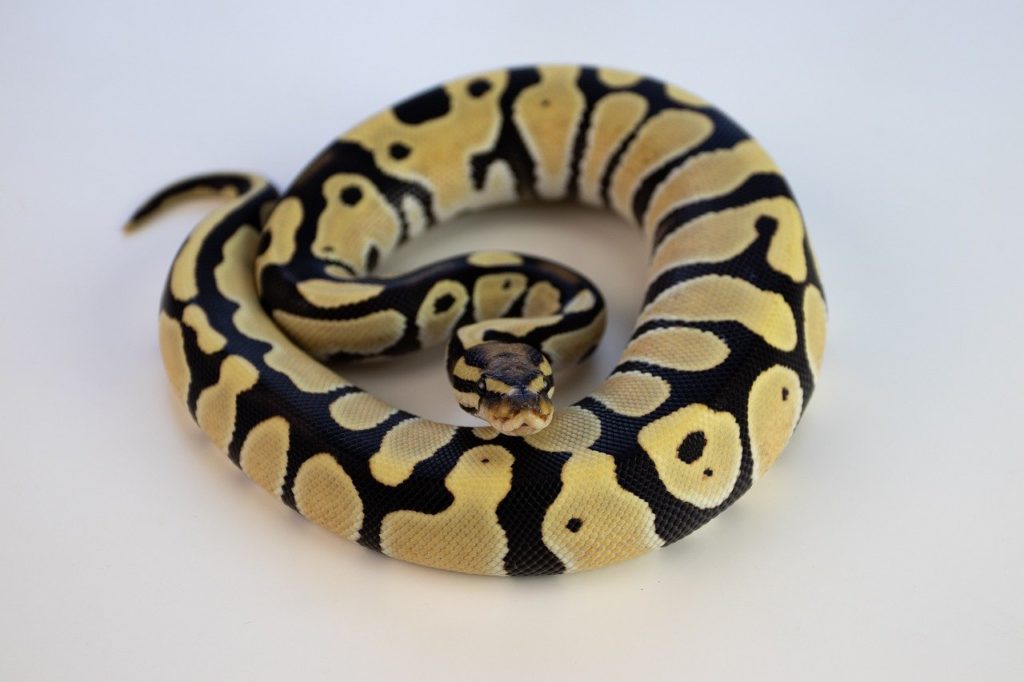
Things have obviously changed a bunch over the last few decades. Now, you can find a variety of different python morphs on the market, including ball pythons.
And while some of the rarest mutations are still pretty expensive, you can pick up a surprisingly large number of morphs for “reasonable” sums of money these days.
But this actually creates a bit of a conundrum for those who’re new to ball pythons and are considering picking up a new morph: It’s all very overwhelming.
There’s a lot to learn about how mutations work, and you’ll also need to decide which morphs you’d like to keep yourself.
We’ll dive in below and try to explain everything you need to know about ball python morphs.
Quick Navigation
What Are Morphs?
“Morphs” is a colloquial term that keepers apply to ball pythons (or other snakes) who possess genetic mutations that cause them to exhibit different physical attributes – usually involving the snake’s color and/or pattern.
However, many mutations not only cause the snake to look different, but some also cause changes in behavior, physiology, and overall fitness.
In the strictest sense of the term, morphs should have the capability of passing on the genes responsible for their unusual appearance in a statistically predictable fashion.
That doesn’t always mean the offspring of a morph will resemble the morph (more on this later), but it does mean that morphs are considered different than animals whose unusual appearance is simply the result of random, individual variation.
Morphs aren’t inherently better than normal ball pythons – in the wild, many would stick out like a sore thumb and quickly end up in a predator’s belly.
Because humans often prize novelty, ball python morphs are very popular with many ball python enthusiasts.
Science of the Situation: Gene Expression and Patterns of Inheritance
As mentioned earlier, the term “morph” is best reserved for animals that pass on their unusual appearance in a predictable fashion.
However, different mutations are passed on and expressed in different ways.
To explain, we’ll need to start by reviewing a little high school biology.
Gene Expression
Genes are bits of DNA that explain how to build a snake (or banana, or blue whale or begonia). And, like many other organisms, snakes have two copies of each gene – one comes from each parent.
Often, those genes are more-or-less identical. This means that both genes are explaining how to build the snake in the same way, so there’s no mystery to the process.
Both genes carry the same instructions for making “this” part of the snake brown, or “that” part of the snake black.
But sometimes, one of the genes is different in one or more key ways, which creates an obvious issue – which one of the genes will control how the snake is built? Or, as biologists would put it, which one of the genes will be expressed?
Sometimes one gene or the other will “take the lead,” meaning that it will be expressed and provide the relevant instructions for the organism. But, at other times, both genes will both contribute to the construction of the snake.
Genes that take the lead in these circumstances and become expressed are called dominant genes; those that are silenced in such cases are called recessive genes. Genes who are expressed together are called co-dominant or incomplete dominant.
This means that if a snake has a single copy of a dominant gene, it will display the associated characteristic.
On the flip side, a snake with a single copy of a recessive gene will not exhibit the associated characteristic.
It takes two copies of a recessive gene to produce changes in the snake’s appearance.
Co-dominant and incomplete dominant genes aren’t so black-and-white; they tend to exert a moderate effect on the snake’s appearance when they occur singly.
When found in pairs, these genes often cause a more extreme variant of the same trait.
There are some nuanced differences between co-dominant and incomplete dominant traits, but for our purposes here, we can use the terms interchangeably.
Patterns of Inheritance
None of the details of gene expression matter to the average keeper who simply wants a cool-looking snake. You can simply pick out a snake that has the appearance you want and call it a day.
But, if you intend to breed morphs, it is important to understand how these mutations are passed on to offspring.
Let’s take the albino morph as an example.
The albino trait is a simple recessive mutation. This means snakes with one copy of the gene appear normal, while those with two copies of the gene will appear albino.
Snakes with two identical copies of a gene are said to be homozygous for the trait, while those with one copy of each gene are said to be heterozygous.
Colloquially, snake keepers often call heterozygous snakes “hets.”
This means that there are six different possible combinations of animals you could pair, and each will produce a different ratio of gene combinations (statistically speaking).
We explain each and outline the expected outcome below.
Normal x Normal
All offspring appear normal. There is no albino gene in the mix, so there’s no other possibility.
Normal x Albino
All offspring appear normal, but half of them (who receive one copy of the albino gene from their albino parent) are heterozygous for albinism.
Heterozygous x Normal
All offspring appear normal, but one-quarter of the offspring are heterozygous for the albino trait.
Heterozygous x Heterozygous
One-quarter of the offspring appear albino, as they receive the albino gene from each parent.
Fifty percent of the remainder get one copy of the gene, so they’re heterozygous for albinism. The remaining quarter of the offspring are entirely normal.
Heterozygous x Albino
One half of the offspring will appear albino, while the remainder will all be heterozygous for the albino trait.
Albino x Albino
All offspring appear albino. There is no normal gene in the mix, so there’s no other possibility.
Of course, this only explains how to predict the offspring arising from a breeding involving a recessive gene.
Dominant, co-dominant/incomplete dominant genes are passed on in other ways.
Dominant genes can present a conundrum for breeders, as it is impossible to tell whether an animal has one or two copies of the dominant gene – all it takes is one copy to trigger the unusual appearance.
Fortunately, there aren’t many dominant ball python morphs.
Incomplete dominant and co-dominant genes are easiest to understand by thinking of the heterozygous form as being an “indicator” of the gene.
From there, you can simply treat the trait as recessive – just consider the “super” form the actual morph, and those with a single copy of a gene are akin to “visual hets.”
Take, for example, the pastel trait, which is co-dominant/incomplete dominant.
If you treat super pastels (those with two copies of the gene) like you would an albino (which also has two copies of the mutated gene), the math works out the same way.
So, if you bred two pastels together, it would generate the same ratios as you’d get when breeding to snakes that were heterozygous for albinism:
One-quarter of the offspring would be super pastels (akin to albinos), half of the offspring would be pastels (akin to heterozygous for albino), and one-quarter would be completely normal.
The only major difference is that with co-dominant/incomplete dominant traits, you can see which animals are heterozygous, which you cannot do with albinos or other recessive morphs.
13 of the Most Notable Ball Python Morphs & Mutations
Now that you have a basic understanding of what ball python morphs are and how their traits are passed on, we can examine a few examples.
Below, we’ll briefly describe 13 particularly noteworthy morphs and explain some of the most important characteristics of them.
1. Albino
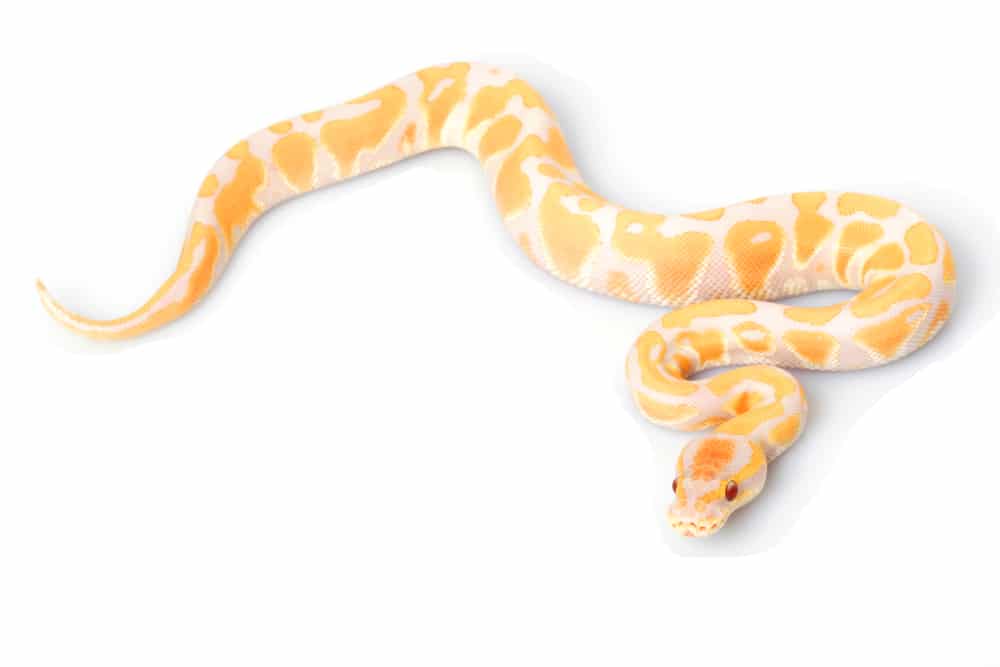
Technically, “albino” ball pythons are better described as being amelanistic, as they do produce pigments, they just don’t produce dark brown/black pigments.
Nevertheless, you’ll almost always see the term albino used to describe these snakes.
There are several different genes that can produce albino ball pythons, and each tends to create a slightly different characteristic look. Most are essentially white (or off-white) and yellow snakes.
The albino morph does not cause any pattern abnormalities – they look like normal ball pythons with different paint jobs.
The albino mutation was one of the first established ball python morphs, dating back to the 1990s.
As mentioned above, the albino trait is a simple recessive mutation, meaning that an animal must have two copies of the mutation to appear albino.
As occurs with other recessive mutations, the number of albino ball pythons available grew slowly.
This kept their price very high for many years, but they are currently available at very reasonable prices.
2. Pastel
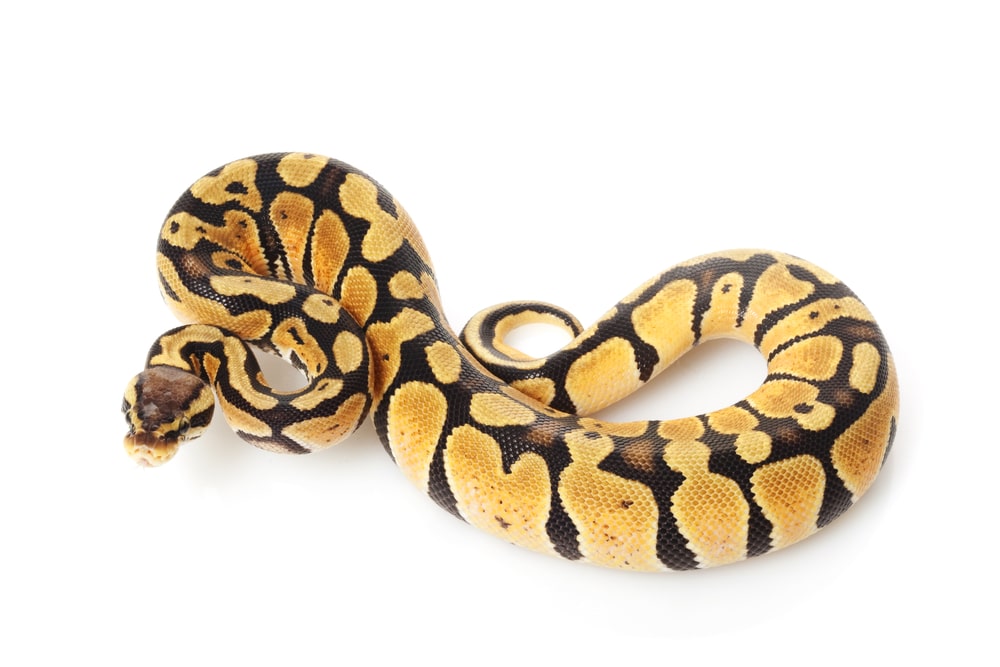
The pastel mutation is an incomplete dominant/co-dominant mutation that alters the animal’s color and pattern.
Animals with a single copy of the pastel gene are typically called “pastels,” while those bearing two copies of the gene are called “super pastels.”
The pastel mutation often causes snakes to have a slightly aberrant pattern, but the most notable characteristic of the mutation is reduced (but not absent) melanin.
This makes the dark portions of their color patterns to appear as a brown/lavender color, and the areas that are typically brown are much brighter, bordering on yellow.
Super pastels appear like more extreme versions of pastels.
They’re even brighter/lighter in color, and their patterns are even more unusual looking.
Pastel ball pythons are barely more expensive than normal looking ball pythons, and even super pastel ball pythons – which commanded four-figure sums in not-too-distant memory – are pretty affordable on the modern market.
3. Spider
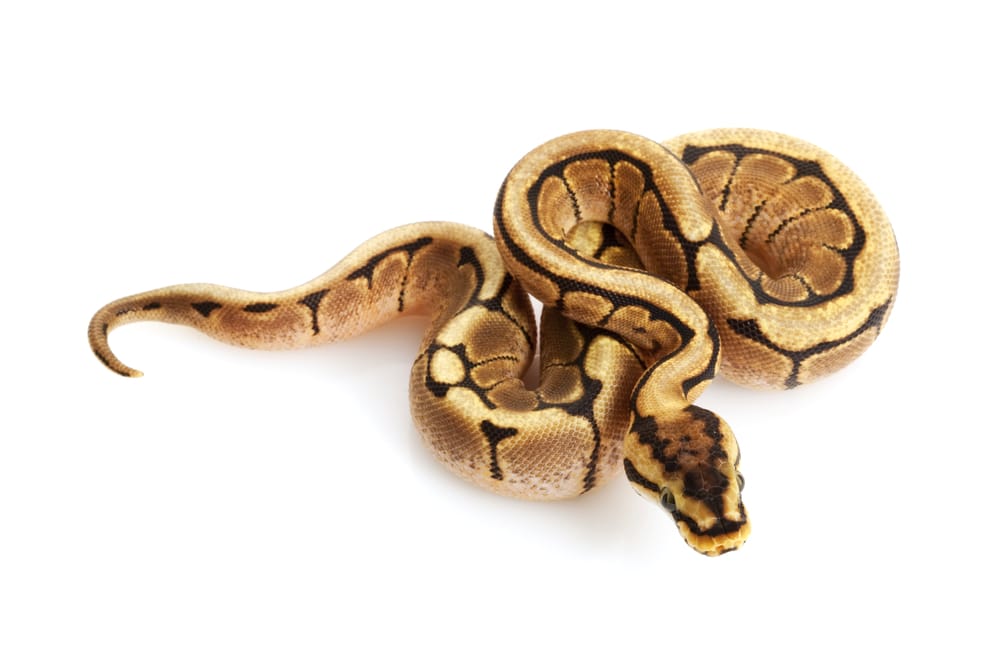
The spider mutation is another morph that has been around for a while, and it is a bit of an infamous mutation as well, for reasons we’ll discuss in a moment.
Spider ball pythons have very reduced patterns, characterized by large brown to yellow patches, and relatively thin dark markings that convey a vaguely spiderweb-like aesthetic (hence the “spider” name).
They often have white markings along the lateral body surfaces, and their colors are often brighter than they are in normal ball pythons.
The spider morph appears to affect the snake’s biology as well as its appearance.
Many (if not all) spider ball pythons appear to “wobble” or exhibit uncoordinated body movements.
This has led some breeders to stop working with the morph entirely, but other keepers continue to breed them, so they remain available.
The spider mutation essentially operates like a dominant trait, although it could actually be an incomplete dominant or co-dominant trait.
The problem is, no “super” form has ever been documented.
This would normally mean that it is a dominant mutation, but it is also possible that it is an incomplete dominant/co-dominant trait, but the “super” form is lethal (as occurs in some other mutations found in other species).
4. Mojave
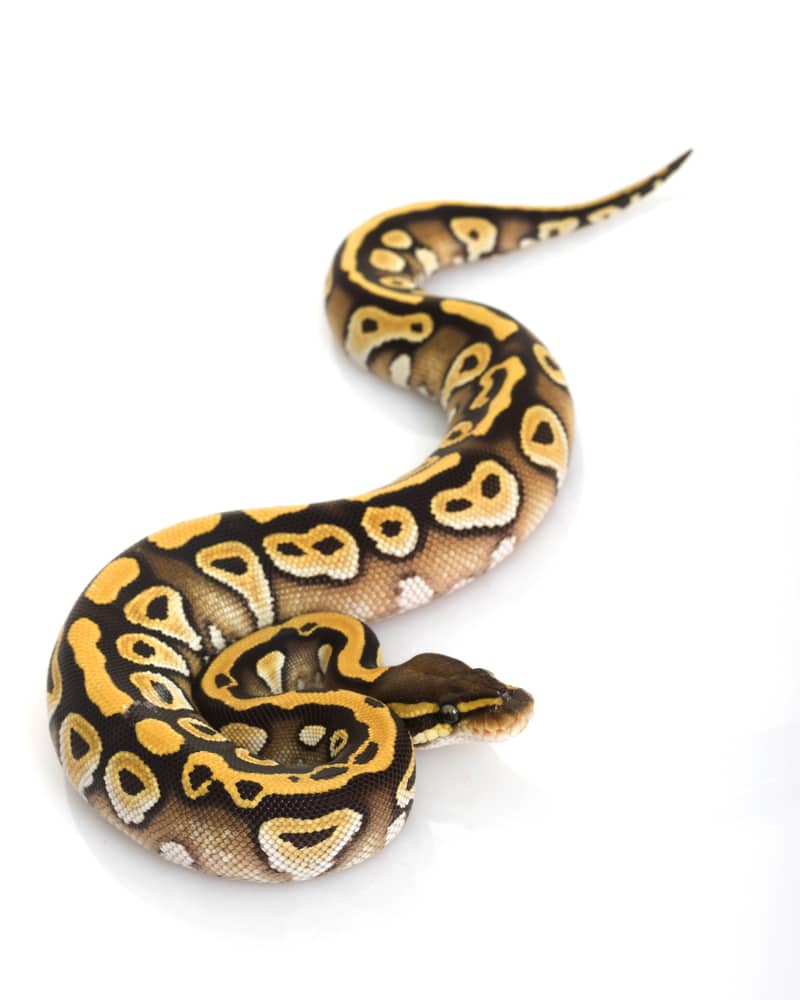
The Mojave mutation is a very interesting and popular incomplete dominant/co-dominant ball python morph.
Snakes with one copy of the Mojave gene exhibit a very high-contrast color pattern, with oddly shaped lateral markings.
The light and dark pattern elements are also much lighter than normal, and they have patternless bellies.
But while one copy of the Mojave gene creates snakes with an attractive, if unspectacular, color pattern, two copies of the gene create an unreal-looking snake that is all white, with blue eyes – the so-called “blue-eyed lucy.”
The term “lucy” is short for leucistic, which refers to snakes that are all or mostly white but have blue or black eyes.
Given the fact that Mojaves can produce blue-eyed lucies, the morph has remained popular, despite having been around for quite some time.
Nevertheless, simple Mojaves can be obtained for relatively reasonable prices.
5. Fire
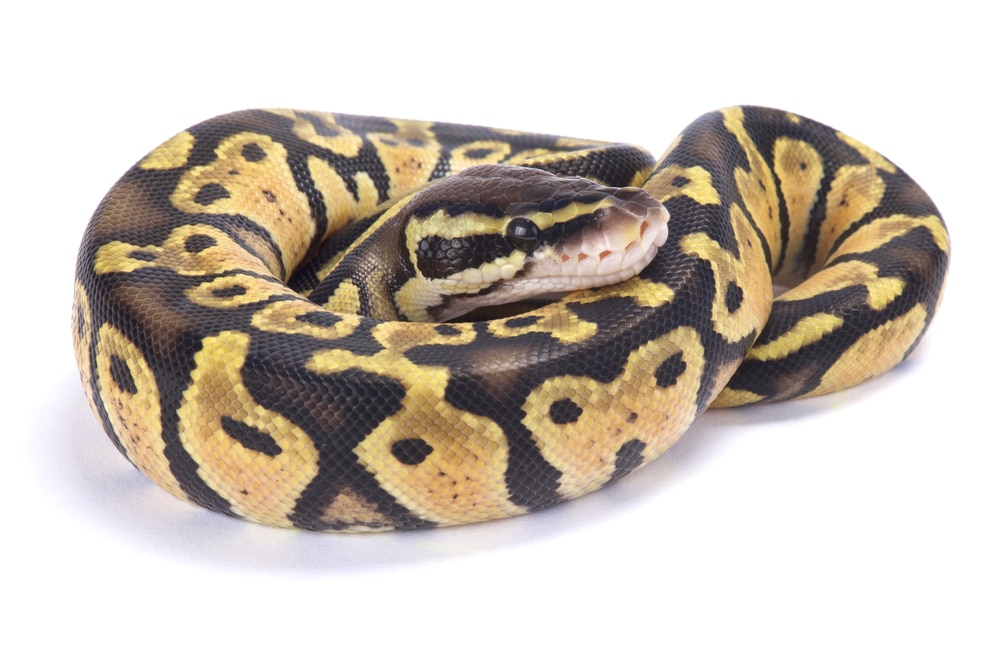
The fire morph is another morph co-dominant/incomplete dominant mutation for ball pythons.
Animals that only have one copy of the gene look pretty ordinary, although their gold/brown colors are much richer than normal, and their dark pattern elements are a bit warmer than usual.
However, animals that have two copies of the gene (making them “super fires”) are amazing to behold.
They’re completely white animals with black eyes. Keepers and breeders often call them “black-eyed lucies.”
The fire mutation is a bit newer than many of the mutations that have been available for a decade or more, but because the trait is incomplete dominant, their numbers have grown rapidly.
This means that their price tag is much more reasonable than you may expect, given what they’re capable of producing.
6. Axanthic
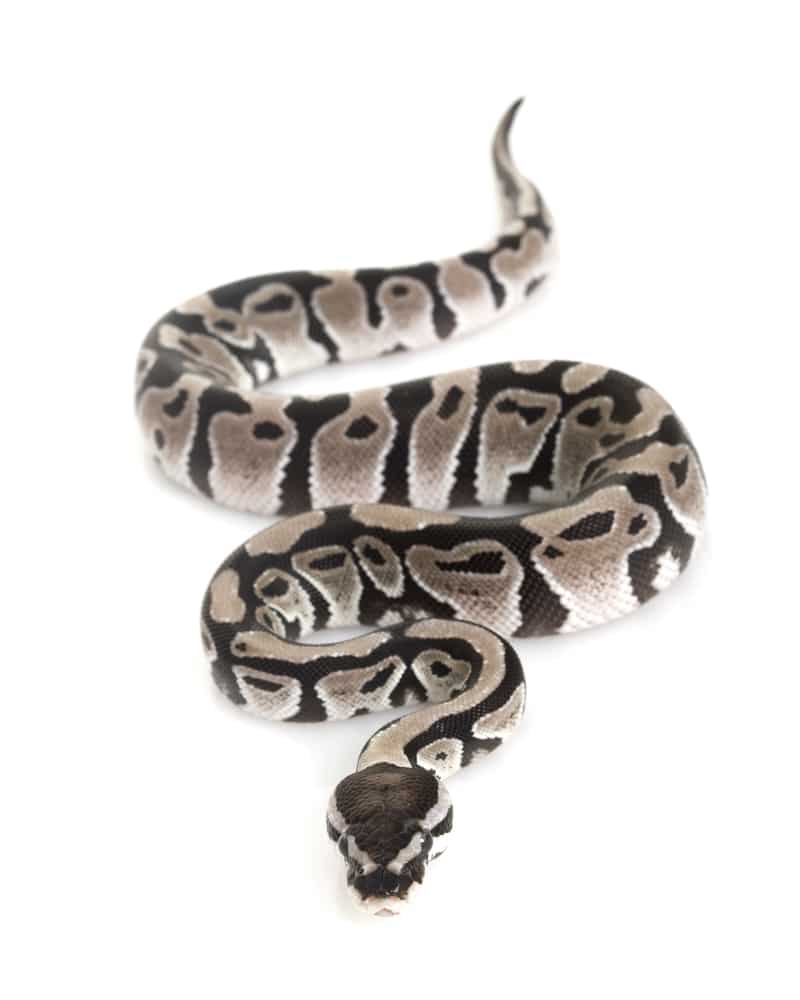
Axanthic ball pythons are interesting looking snakes, even if they aren’t particularly jaw-dropping.
The axanthic gene prevents a ball python from producing yellow pigments, resulting in a snake that looks somewhat black and white, instead of black and brown.
Some keepers find axanthic ball pythons desirable in their own right, but they’re probably most celebrated for the potential they offer for combination breeding projects.
For example, by combining the albino gene with the axanthic gene (via a multi-generation breeding project), you can create a small number of snakes that are essentially all white.
The axanthic morph is passed on in simple recessive fashion, but because they’re not the most flamboyant snakes, their price tag hasn’t remained high for as long as many other simple recessive traits.
7. Lesser Platinum / Butter
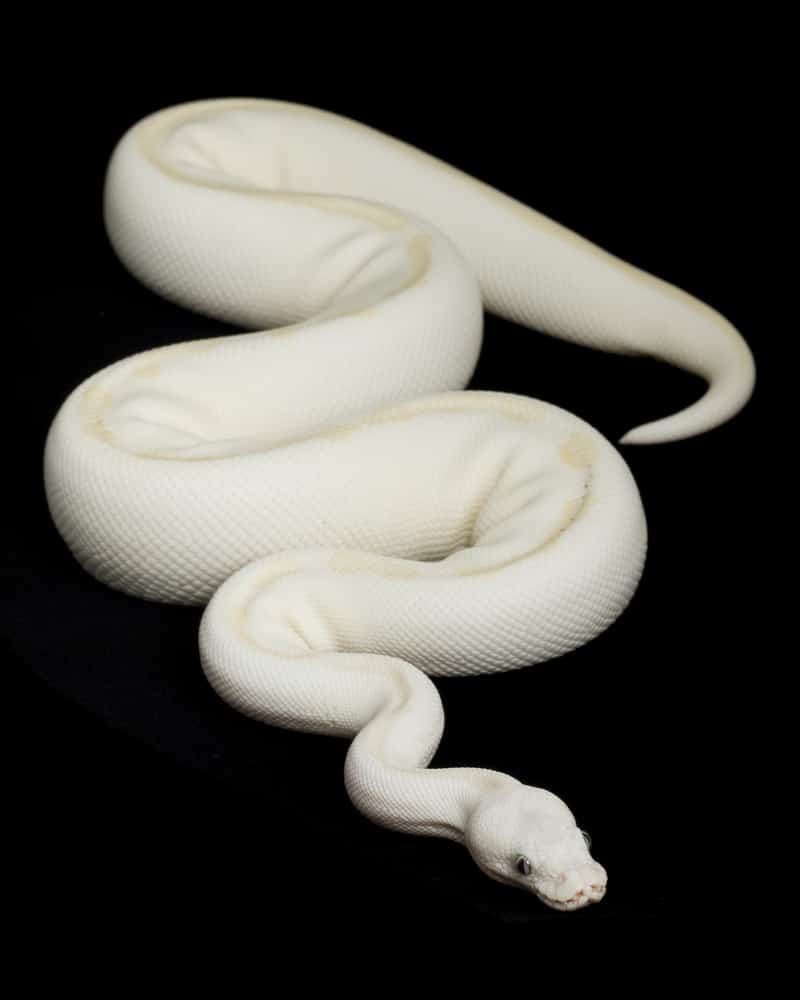
The lesser platinum and butter traits are a bit unusual. They both look pretty similar, but they appear to be different mutations.
Here’s the weird thing: The traits are compatible with each other.
It’s difficult to describe the appearance of butters and lesser platies (as they’re often called), but their colors are lighter than usual – much lighter in some cases.
Their patterns are typically pretty normal. Both traits are inherited in co-dominant/incomplete dominant fashion, so butters and lesser platies have one copy of either mutated gene.
The interesting thing happens when a snake gets any two of these mutated genes. You end up with an all-white snake with bright blue eyes – the so-called “blue-eyed lucy.”
These are fantastic looking animals, and they are quite popular with many ball python enthusiasts.
8. Clown
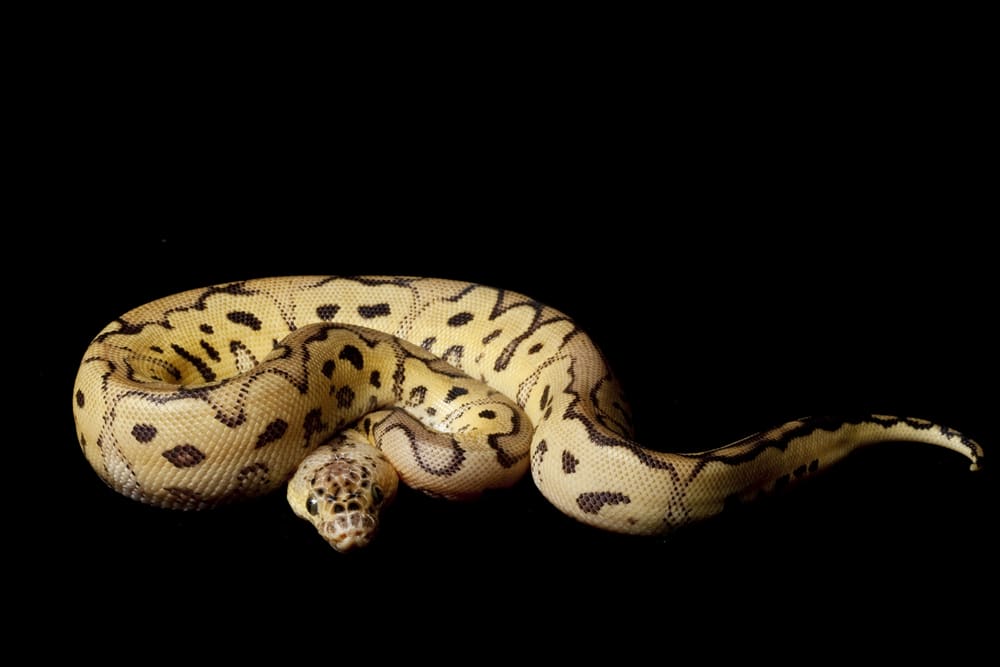
The clown morph affects a ball python’s color and pattern, but it’s pretty variable; some clown ball pythons are spectacular-looking animals, but others are only slightly more interesting than normal ball pythons.
In a best-case scenario, a clown ball python will exhibit very rich yellow to orange markings against a chestnut to light brown background.
The dark pattern elements are typically quite reduced, and a vertebral stripe is often present.
Additionally, clown ball pythons often have unusual head and face markings.
The clown morph is passed on in simple recessive fashion. This means that their numbers have grown more slowly than many of the co-dominant/incomplete dominant traits on the market, which has kept their price high.
However, they’re now available for relatively reasonable sums and within the range of many keepers.
9. Piebald
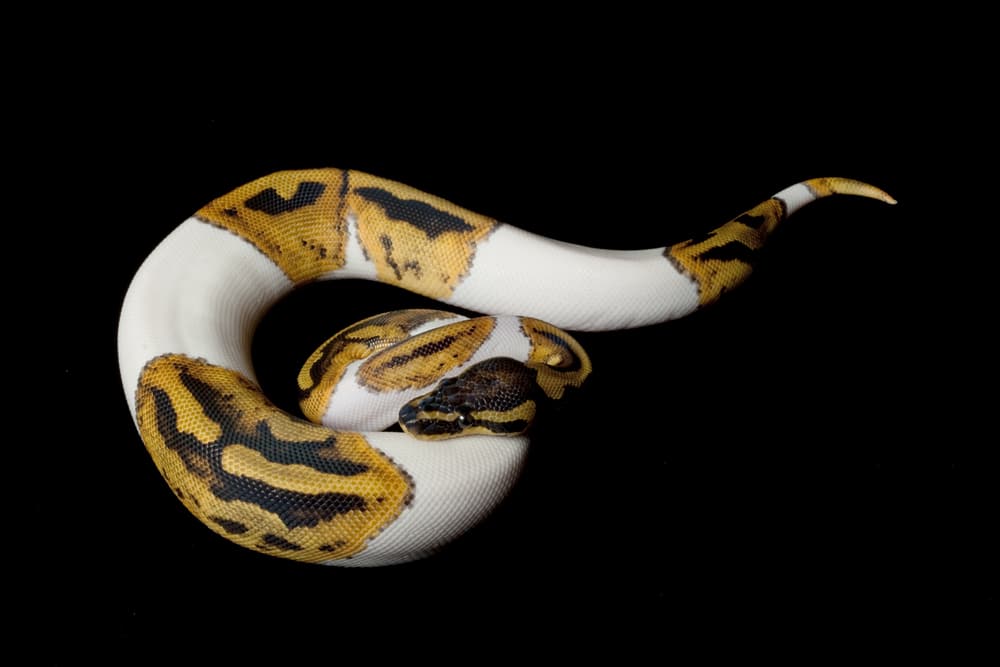
They may not be everyone’s cup of tea, but piebald ball pythons are unquestionably striking animals. Piebald snakes essentially have two different patterns.
Some percentage of their bodies look like normal ball pythons, but the remainder features immaculate white bands or blotches.
In some cases, these animals can appear largely white, with only small areas that exhibit a typical ball python color pattern.
Generally, those snakes with more white markings fetch higher prices.
The piebald trait is passed on in simple recessive fashion. When combined with their popularity, this has helped the mutation to retain its value quite well.
10. Caramel (T+)
Caramel ball pythons are thought to exhibit a unique type of albinism termed tyrosinase positive albinism.
Without getting into the weeds any more than necessary, the mutation at work here interrupts the melanin-production process at a different stage of the game than the typical (tyrosinase negative) albino mutation does.
Biochemical details aside, the result is a beautiful animal, clad in a typical pattern, but a lavender-to-peach color scheme.
The caramel mutation is passed on in simple recessive fashion, but they’ve been around for a while, so they’re reasonably common (read: affordable) on the modern market.
11. Yellow-Bellied
The yellow-bellied trait is inherited in incomplete dominant/co-dominant fashion. The morph causes ball pythons with a single copy of the gene to exhibit relatively subtle differences in color.
Their light pattern elements often have tinges of red, orange or yellow mixed in, and their ventral surfaces are typically an unmarked wash of white, with varying amounts of yellow mixed in.
However, very special things happen when snakes receive two copies of the yellow-bellied gene.
The result is a patternless (or nearly so), peach-colored snake with dark eyes. They’re quite beautiful to see in person, and keepers tend to call them “ivories.”
The yellow-bellied ball python remains relatively affordable, as those with only one copy of the gene aren’t particularly impressive, and, being a co-dominant/incomplete dominant trait, their numbers have risen steadily.
12. Pinstripe
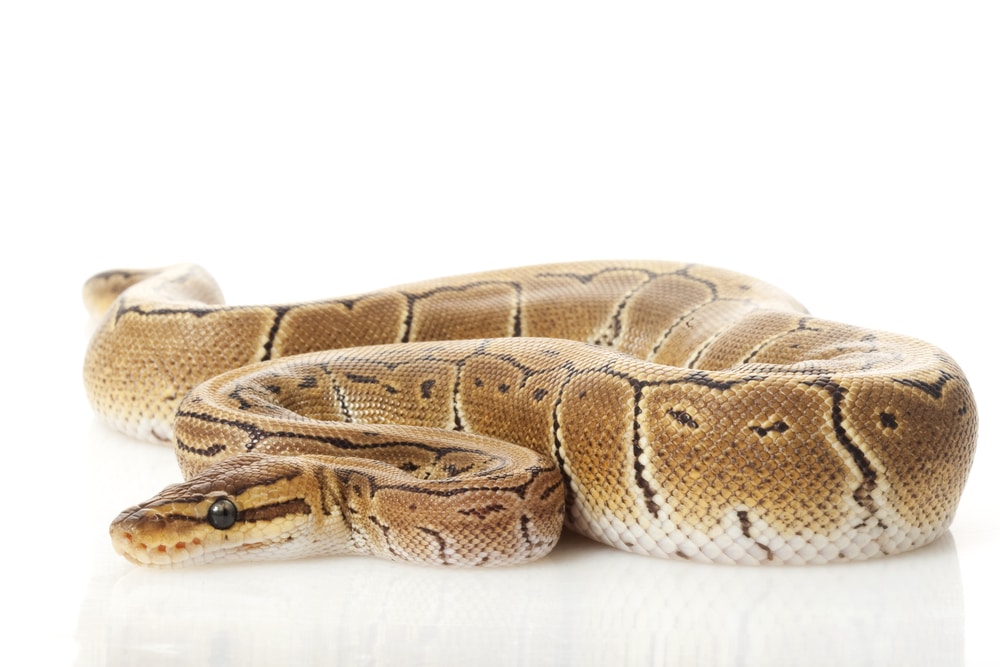
The pinstripe morph is unusual in two ways: It is a pattern mutation that doesn’t alter the animal’s color, and it is inherited in dominant fashion.
Pinstripe animals have very reduced dark pattern elements, which gives the overall impression of thin black webbing, and a light brown dorsal stripe.
They’re very attractive animals, and they’re also very useful in mixed-morph breeding programs.
Because this trait is inherited in dominant fashion, there is no visual difference between an animal that has one copy of the gene and an animal that has two copies.
However, the animal with two copies of the gene would only be capable of producing other pinstripe ball pythons.
13. Ghost

Ghost ball pythons are somewhat similar to axanthic ball pythons in that they’re probably most appreciated for their use in multi-morph breeding projects.
Ghost ball pythons are hypomelanistic – they produce melanin, but they do so in less than normal quantities.
This means that they don’t look like albinos; they look like “washed out” ball pythons. Other keepers characterize them as having a “hazy” appearance.
But, when combined with other color or pattern mutations, they can elevate the results to another level.
The ghost trait is inherited in a simple recessive fashion, but it is important to note that there are several different ghost mutations available, and they are not compatible with each other.
Conclusion
There are many, many other ball python traits available, but the 13 described above are among the most celebrated and readily available to would-be keepers.
Of course, there are also countless combinations that these different traits can produce, meaning that the only limits to ball python color and pattern variations are our own imaginations.
Personally, I’m a huge fan of the all-white (or nearly white) morphs, as well as the caramel mutation.
Unlike a lot of other ball python keepers, I’m not really a fan of the piebald mutation – different strokes and all that.
What are your favorite morphs? Let us know in the comments below.